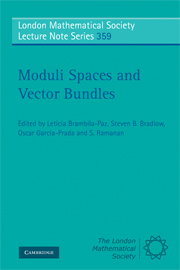Book contents
- Frontmatter
- Contents
- Preface
- Acknowledgments
- Part I Lecture Notes
- 1 Lectures on Principal Bundles
- 2 Brill-Noether Theory for Stable Vector Bundles
- 3 Introduction to Fourier-Mukai and Nahm Transforms with an Application to Coherent Systems on Elliptic Curves
- 4 Geometric Invariant Theory
- 5 Deformation Theory for Vector Bundles
- 6 The Theory of Vector Bundles on Algebraic Curves with Some Applications
- Part II Survey Articles
- Part III Research Articles
5 - Deformation Theory for Vector Bundles
Published online by Cambridge University Press: 07 September 2011
- Frontmatter
- Contents
- Preface
- Acknowledgments
- Part I Lecture Notes
- 1 Lectures on Principal Bundles
- 2 Brill-Noether Theory for Stable Vector Bundles
- 3 Introduction to Fourier-Mukai and Nahm Transforms with an Application to Coherent Systems on Elliptic Curves
- 4 Geometric Invariant Theory
- 5 Deformation Theory for Vector Bundles
- 6 The Theory of Vector Bundles on Algebraic Curves with Some Applications
- Part II Survey Articles
- Part III Research Articles
Summary
Abstract
These expository notes give an introduction to the elements of deformation theory which is meant for graduate students interested in the theory of vector bundles and their moduli.
Introduction : Basic examples
For simplicity, we will work over a fixed base field k which may be assumed to be algebraically closed. All schemes and all morphisms between them will be assumed to be over the base k, unless otherwise indicated. In this section we introduce four examples which are of basic importance in deformation theory, with special emphasis on vector bundles.
Basic example 1: Deformations of a point on a scheme
We begin by setting up some notation. Let Artk be the category of all artin local k-algebras, with residue field k. In other words, the objects of Artk are local k-algebras with residue field k which are finite-dimensional as k-vector spaces, and morphisms are all k-algebra homomorphisms. Note that k is both an initial and a final object of Artk. By a deformation functor we will mean a covariant functor F : Artk → Sets for which F(k) is a singleton point. As k is an initial object of Artk, this condition means that we can as well regard F to be a functor to the category of pointed sets.
- Type
- Chapter
- Information
- Moduli Spaces and Vector Bundles , pp. 128 - 164Publisher: Cambridge University PressPrint publication year: 2009
- 4
- Cited by



